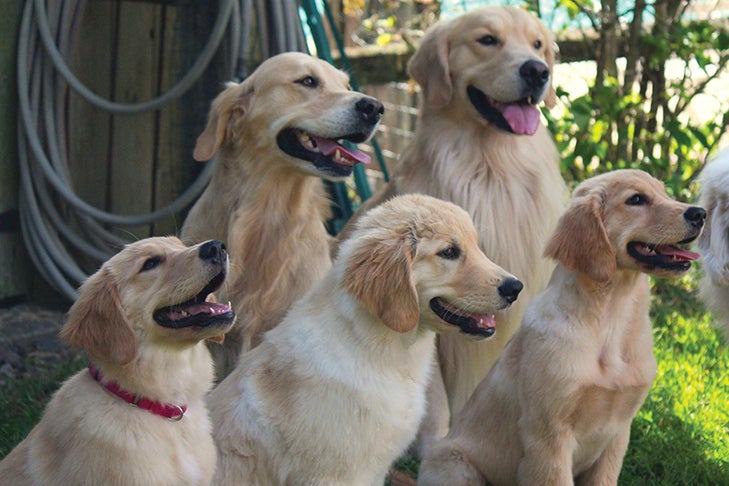
With a three-legged hop and a skip, 6-year-old Ari, aka Hero No. 1651, knows how to work a crowd. Giving his amputated limb the cold-shoulder, the Golden Retriever with the soft, friendly eyes can’t wait to cheer up anyone who needs a dose of happy.
His specialty? Hospice patients, nonverbal people, children using wheelchairs, and those with special needs.
Ari’s owner, Sue Cowan, says he has a knack for knowing who needs him. “Minutes before we drive up to a group home, his tail starts swishing, and I know he’s excited. But two years ago, Ari did something unusual,” she remembers. “I opened the car door to lift him out, and he made a beeline for the facility.”
On that day, what propelled this certified therapy tripod to run like lightning?
A girl having a full-blown meltdown.
“No one could soothe her, but when Ari pressed his head into her chest, she calmed down,” says Cowan, of Carver, Massachusetts. “I never trained him to give a hug with the right amount of comfort, but it worked.”
The child reached to touch Ari’s lustrous coat but lacked coordination.
“When I gently placed her palms on his head, she smiled,” recalls Cowan.
In the past five years, Cowan and Ari, an AKC Canine Good Citizen and Therapy Dog Excellent, have frequented nursing homes. They recently added elementary schools to open conversations about bullying.
“I’ll say to the kids, ‘Look at Ari. He was born with a badly twisted leg requiring amputation,’ ” Cowan says. “Ari looks different than other dogs with four legs, but he found a way to walk and run that works for him.”
She tells children to not to feel sorry for him. “He’s loving and kind, and that’s what important.”
Cowan says she can’t identify who most needs the Golden’s touch, but this dog with the 14-karat heart does.
“He zeroed in on the kids who were hurting and knew that a goodbye hug for them could mean the world,” Cowan says.
Happy Hearts
 Such is the healing power of a Golden Retriever.
Such is the healing power of a Golden Retriever.
The gold standard of therapy, sporting, and companion dogs, the breed is well-known for its go-all-out-to-please-you personality.
Mary Margaret Callahan is the chief mission officer of Pet Partners, which registers therapy dogs for animal-assisted interventions. She notes that 1,400 Goldens hold the top spot of registered breeds on their list of 12,200 canine teams.
With a double coat ranging from liquid amber to a light red, these butterscotch beauties project an intelligent, understanding, up-for-anything attitude.
They serve as guide dogs, search-and-rescue workers, and four-footed comfort responders for communities in crisis.
They check the box as avid hikers and swimmers and eager dog-sport competitors. In the field, they are standouts among other retrievers for their soft mouths. Their prized trait of picking up and transporting game without tearing it to pieces endears them as hunting companions.
Come nighttime at home, they’ll demand the sofa and hog the bed.
It’s no wonder that of 195 recognized breeds, Goldens rank third in AKC breed popularity and have been in the top-10 rankings since 1976.
Now, they are taking a leading role at the forefront of scientific research.
Golden Globes
As celeb breeds go, Ari and 3,043 other Golden Retrievers merit Oscar-worthy consideration. They belong to an exclusive club—the Morris Animal Foundation’s $32 million Golden Retriever Lifetime Study.
These dogs, known as heroes who receive a number when they enter the study, may someday unlock the mystery of why Goldens are at high risk of cancer.
“Fifty-four percent of the breed’s deaths are due to one of four types of cancer: lymphoma, high-grade mast cell tumor, hemangiosarcoma, and osteosarcoma,” says Kelly Diehl, DVM, DACVIM (SAIM).
Of these, 90 to 95 percent are due to hemangiosarcoma and osteosarcoma, says Diehl, senior director of scientific programs and communications at Morris Animal Foundation.
The idea for the study was born after a conversation between Bette Morris, a founding Morris member, and Rodney Page, an oncologist, and director of the Flint Animal Cancer Center at Colorado State University. They were talking about high cancer rates in the breed.
It is modeled after the ongoing Framingham Heart Study, which began evaluating residents in Framingham, Massachusetts, in 1948. Framingham established coronary heart disease risk factors, such as high blood pressure, diabetes, and cigarette smoking.
By collecting nutritional, environmental, lifestyle, and genetic data from Golden owners and their veterinarians, researchers hope the findings will provide answers for future generations.
In 2012, the Morris Animal Foundation (MAF) reached out to the Golden Retriever Club of America to enlist Goldens between the ages of 6 months and 2 years for the study. Three years later, the study reached its enrollment limit of 3,000 Goldens, with 44 additional dogs as a safety net. No additional dogs will join.
AKC-registered Goldens with a three-generation pedigree living in the continental U.S. were eligible.
Cathy Blimline, of Shillington, Pennsyvania, volunteered her show dogs—Gideon, No. 2048, and Callie, No. 243, a therapy, obedience, and Rally competitor.
“If I could make a difference, why not?” Blimline says.
After losing two Goldens to hemangiosarcoma, Paul and Shari Walliker, of Galva, Illinois, bought two Golden puppies—Boomer, No. 2717, and Oliver, No. 2818. When Boomer developed lymphoma, the Wallikers spent $10,000 to save him.
“I didn’t hesitate to join the study,” Paul Walliker says. “It will be transformative for the breed.”
Once a year, owners fill out a lengthy questionnaire about their dogs and take them to their participating veterinarian for laboratory testing.
Diehl says 91 percent of the original dogs remain in the study. A few died or moved to Hawaii or Alaska.

Numbers Game
Cowan heard about the study from her veterinarian, Mike Lappin, in Buzzards Bay, Massachusetts, whose 8-year-old Isaac is No. 64. Lappin performs the yearly required lifetime exams for 17 Goldens and donates the cost to the study.
“It takes about one and a half hours to examine each dog, but someday I’m hopeful we’ll have some answers,” Lappin says. “In 1972, the average life span of Goldens in my practice was 15 to 17 years, but now it’s 10 or 10½ years.”
Lappin and participating veterinarians in the study collect two sets of data, which include fecal and urine samples, blood panels, and hair and nail clippings. One set is stored for future discovery.
“We call these dogs heroes because they won’t benefit from all the poking and prodding they endure,” says Beth Bernstein of Carolina Beach, North Carolina, who has owned 13 Goldens. Eleven died from hemangiosarcoma. “We may never know how much these dogs are giving to future generations of Golden Retrievers and other breeds.”
An early volunteer for the study, Bernstein coordinates a Parade of Heroes at every Golden Retriever Club of America National Specialty. Hero owners wear medallions for the 158 deceased Angel Goldens.
“Participants in this study are incredibly devoted to their dogs and the other heroes,” says Annie Li, MAF liaison for Golden volunteers.
A private online community of hero-dog owners developed with two Facebook pages to keep everyone connected.
If an owner is diagnosed with cancer and must undergo chemo, people in the study send clippings of their dog’s hair to the Magical Golden Fibers project to help with treatment. A few members make a purple blanket, embroider a Golden Retriever on the front, and sew the hair inside a pocket.
“These owners believe their Goldens possess healing powers, not only for the body but the soul as well,” Li says.
Originally ran in the March/April 2020 issue of AKC Family Dog.


